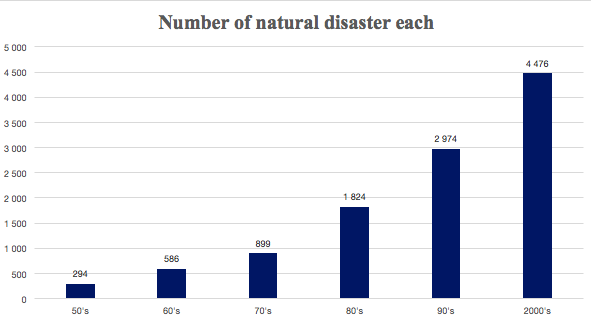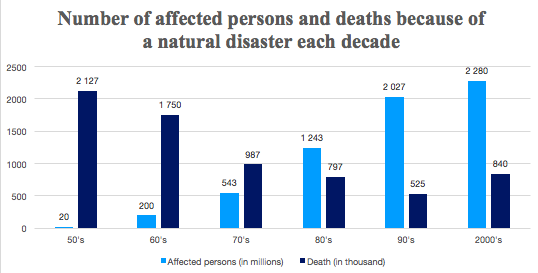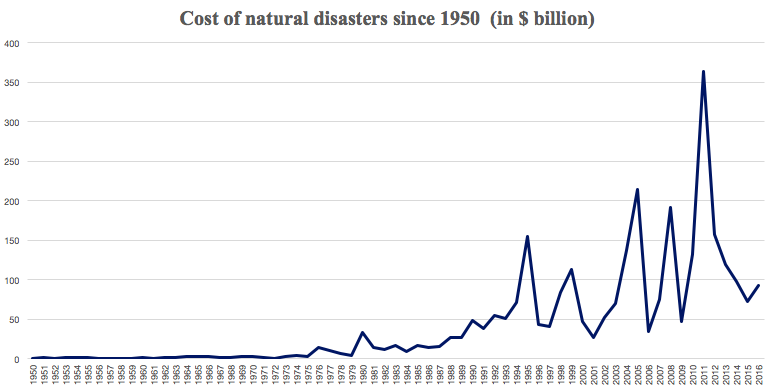
SafeTogether
Presentation file
SafeTogether - An application to inform, prevent, protect and care people about the natural disasters in French Antilles


SafeTogether - An application to inform, prevent, protect and care people about the natural disasters in French Antilles
Climate change has been a major topic ever since the publication of the report of the Intergovernmental Panel on Climate Change (IPCC) in the 1980s. Climate change is one of the greatest challenges of this century and the centuries to come that our generation has to address.
The growth of climate change and global warming, accelerated by human activities, bears direct consequences for civil population: among other the increase of natural disasters. The number of natural disasters has increased to reach 448 natural disasters each year during the 2000s. In average, there were 15 times more natural disasters during the 2000s than during the 50s. More and more people are affected by natural disasters, the number doubled between the 80s and 2000s. The costs of natural disasters are exponentially rising, from $18 billion each year during the 80s to $148 billion each year during the 2010s.
 ,
, 

In August and September 2017, Hurricane Harvey (category 4) and Hurricane Irma (category 5) have devastated the regions of the Carribeans and the Gulf of Mexico. These two hurricanes killed more than 115 people, thousand were affected and caused more than $250 billions of damage.
The French Premier Ministre Edouard Philippe said about the French islands Saint Barths and Saint Martin :
“95 % of homes have been affected and 60 % are no longer inhabitable”.
“Electricity is cut off, there is no more safe drinking water and fuel is unavailable”.
2017 was a disaster year concerning natural disasters. An increased number of natural disasters are happening in 2017. Hurricane Harvey was the most powerful hurricane in the US since Katrina, the earthquake of Mexico killed 98 people and injured more than 300, Sierra Leone was hit mudslides after torrential rainfalls … 2017 could be the year the most costly about the natural disaster damages.
The increase of natural disaster number and intensity will continue, because the earth temperature will continue rising by a few degrees. The think tank Global Humanitarian Forum estimated that the number of deaths due to natural disasters could be of 500 000 people in 2023 (300 000 people in 2009) and that the natural disaster costs could exceed $600 billion. Nature Climate Change thinks that the world population part exposed to more than 20 days by year at potential fatal heatwaves could increase of 30% in 2016 to 74% in 2100.
Natural disasters do lasting damages to fragile and vulnerable people, because natural disasters affect the livelihoods (food, accommodation …) and could entrain involuntary movement of population. In fact, more than the half of affected people by natural disasters live in fragile states or states in conflict. Furthermore, natural disasters could exacerbate fragilities and conflicts in countries, where governance systems are already failing.
With regards to these assessments and the pessimistic world evolution towards a more frequent occurrence of natural disasters, we face a global and urgent problem. That is the reason why we have decided to orient our project on this topic. Our goal is to reduce the possible dramatic consequences of natural disasters for civil population. In order to fulfill this objective of reducing negative consequences of natural disasters for civil population, we think to create an organization which will be responsible for the creation, development and implementation of an mobile application. We decided to name our organization and application Safe Together.
In order to be efficient and have a real impact on civil population affected by natural disasters, we identify that our application will have to respond to three major needs :
We decided to focus our action on the French Antilles, because the zone was totally devastated by Hurricane Irma in September 2017. Furthermore, we decided to focus on a small scale in order to test and improve our project before a possible international expansion.
We have studied the different charities that already exist to inform, protect and care people before and after a natural disaster. We wanted to offer people added value with our application and not to be an another useless application or project. We are aware that different possibilities already exist in this domain. First of all, we have identified that there are a lot of charities that work in the field. We did not want to substitute to these associations that did and do a great and excellent job for people in need. Second, there are a lot of applications and websites that deal with natural disasters. But we remark that they are not practical, convenient, smart and/or connected. In most cases, theses applications and websites are specialized on a specific topic.
Furthermore, we identify a lack of information for population about the natural disasters, particularly the knowledge of the potential threats which could touch the living or vacancy residence. The procedures to be followed in an emergency ( for example, first-aid intervention, localisation of medical emergency …) are mostly unknown. This lack of information may also be due to the difficulties to find information or the misunderstanding of the information. People are bad informed about the natural disasters, their consequences and how to protect oneself. This misinformation increase the negative consequences of natural disasters, which could be avoided with a full and simple information.
With these different information, we identified the need to create one universal application, easy to use, quick and useful for people in need.